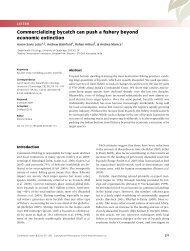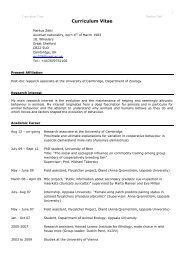Annual Report 2009 - Department of Zoology - University of ...
Annual Report 2009 - Department of Zoology - University of ...
Annual Report 2009 - Department of Zoology - University of ...
Create successful ePaper yourself
Turn your PDF publications into a flip-book with our unique Google optimized e-Paper software.
c) Control <strong>of</strong> DNA Replication<br />
The initiation <strong>of</strong> DNA replication is a crucial point <strong>of</strong> regulation in the cell cycle. Errors at this control point or in the<br />
processes <strong>of</strong> replication itself can lead to mutations and other genetic instabilities. Such genetic changes are the driving<br />
force behind the development <strong>of</strong> cancers and the production <strong>of</strong> genetic diversity, required for evolution. The groups <strong>of</strong><br />
Torsten Krude, Cath Green and Ron Laskey use molecular and cell biology approaches to study DNA replication and<br />
its control in mammalian and amphibian systems.<br />
Christo Christov: Regulation <strong>of</strong> chromosomal DNA<br />
replication and cell proliferation<br />
Simon Cooper: Screening for novel replication factors<br />
Denis Finn: Biochemical analysis <strong>of</strong> replication protein<br />
interactions<br />
Timothy Gardiner: Characterisation <strong>of</strong> Y RNA function in<br />
vertebrate DNA replication<br />
d) Cell Signalling in Animal Behaviour and Development<br />
16<br />
Sebastian Klinge: Structural and functional analysis <strong>of</strong><br />
human DNA polymerase/primase<br />
Alexander Langley: Characterisation <strong>of</strong> Y RNA-protein<br />
interactions during chromosomal DNA replication<br />
Shiphali Shetty: Real time protein-protein interactions at<br />
replication forks in vivo<br />
Alice Zhang: Characterisation <strong>of</strong> Y RNA localisation<br />
during chromosomal DNA replication<br />
We use C. elegans to investigate the molecular networks which underpin the behaviour and development <strong>of</strong> animals. The<br />
group <strong>of</strong> Howard Baylis focuses on how intracellular calcium signalling networks, regulate the animal’s physiology and<br />
development. A recent focus is on the interactions between these pathways and the pathways which cause Alzheimer’s<br />
disease. Birgitta Ol<strong>of</strong>sson’s group is investigating how animals evaluate their food and how they use this information to<br />
make appropriate modifications to their feeding behaviour. Both groups use a combination <strong>of</strong> transgenic, molecular and<br />
genetic techniques together with quantitative analysis <strong>of</strong> whole animal phenotypes.<br />
Roxani Gatsi: Signalling networks controlling growth<br />
Kerrie Ford: IP3 receptor function in C. elegans<br />
Progressive activation <strong>of</strong> CyclinB1-Cdk1 coordinates entry to mitosis<br />
Jonathon Pines<br />
The Cyclin B1-Cdk1 kinase is the catalytic activity at the heart <strong>of</strong> Mitosis<br />
Promoting Factor (MPF), yet fundamental questions concerning its role in<br />
mitosis have remained unresolved. Cyclin B1-Cdk1 has been shown to be the<br />
key mitotic kinase from yeast, through starfish to frog cells but until now it was<br />
not known when and how rapidly Cyclin B1-Cdk1 is activated in mammalian<br />
cells, nor how its activation coordinates the substantial changes in the cell at<br />
mitosis. This is in part because it has so far proved impossible to synchronise<br />
mammalian cells to assay Cyclin B1-Cdk1 biochemically with sufficient temporal<br />
specificity. To overcome this limitation we have developed a FRET biosensor<br />
specific for Cyclin B1-Cdk1 that enables us to measure its activity with very high<br />
temporal precision in individual, living human cells as they divide. This has given<br />
is unprecedented insight into how Cyclin B1-Cdk1 controls entry to mitosis.<br />
We have found that Cyclin B1-Cdk1 is inactive in G2 phase and activated at<br />
a set time before nuclear envelope breakdown. Once activated Cyclin B1-<br />
Cdk1 initiates the events <strong>of</strong> prophase including cell rounding, chromosome<br />
condensation, spindle assembly and finally nuclear envelope breakdown.<br />
Unexpectedly, we find that Cyclin B1-Cdk1 levels rise to their maximum extent<br />
over the course <strong>of</strong> approximately 30 min and that different levels <strong>of</strong> CyclinB1-<br />
Cdk1 kinase activity trigger different mitotic events. This has revealed how the<br />
remarkable reorganisation <strong>of</strong> the cell is coordinated at mitotic entry by rising<br />
levels <strong>of</strong> Cyclin B1-Cdk1 activity.<br />
Reference:<br />
Gavet, O. and Pines, J. (2010) Progressive activation <strong>of</strong> Cyclin B1-Cdk1<br />
coordinates entry to mitosis’. Dev. Cell 18, 533-543.<br />
Amandine Molliex : Presenilin function in the nervous<br />
system<br />
Aniko Nagy: IP3 signalling in development<br />
Cyclin B1-Cdk1 activity measured<br />
in a human cell progressing through<br />
mitosis. High activity correlates with a<br />
high FRET ratio. The measured values<br />
are plotted below the images over<br />
time. The stages <strong>of</strong> mitosis shown are:<br />
prophase; prometaphase (prometa);<br />
metaphase (meta); anaphase (ana.<br />
onset). NEBD = nuclear envelope<br />
breakdown.





